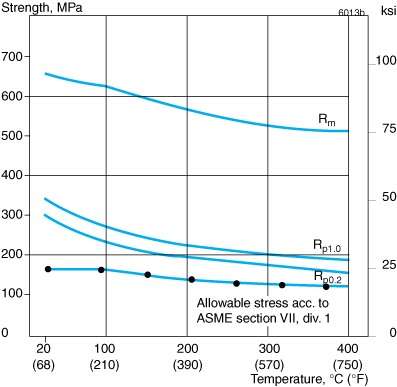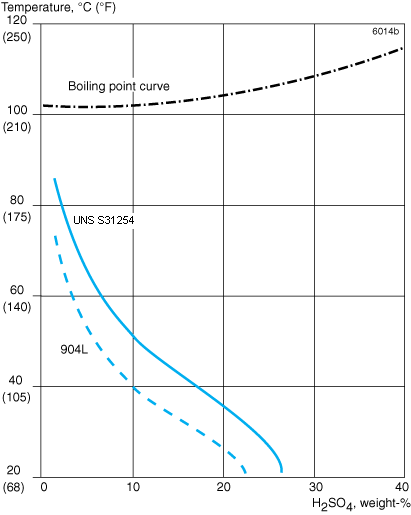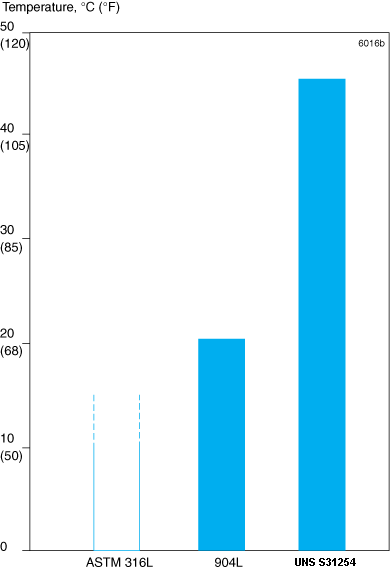ASTM A240 S31254 254SMO cold rolled stainless steel flat sheet
UNS S31254 Sheet
UNS S31254 is a high-alloy austenitic stainless steel developed for
use in seawater and other aggressive chloride-bearing media. The
steel is characterized by the following properties:
- Excellent resistance to pitting and crevice corrosion
- High resistance to general corrosion
- High resistance to stress corrosion cracking
- Higher strength than conventional austenitic stainless steels
- Good weldability
Standards
- UNS S31254
- EN number 1.4547
- EN name X1CrNiMoCuN20-18-7
- W.Nr. 1.4529**
- SS 2378*
- AFNOR Z1 CNDU 20.18.06AZ*
* Obsolete. Replaced by EN.
** Nearest equivalent grade.
Product standards
- Seamless tube and pipe: ASTM A269, A213, A312, NFA 49-217, EN
10216-5
- Welded tube and pipe: ASTM A249, A269 , A312, A358, A409
- Fittings: ASTM A182
- Bar: ASTM A276, A479, EN 10088-3
- Forged products: ASTM A473
- Sheet and plates: ASTM A240
Approvals
- UNS S31254 (254 SMO) in the form of seamless pipe has been approved
by the American Society of Mechanical Engineers (ASME) for use
according to ASME Boiler and Pressure Vessel Code section VIII,
div. 1. However, there is no approval for UNS S31254 in the form of
seamless tube, but according to the ASME paragraph UG-15 it is
allowed to use the design values for seamless pipe according to
ASME section VIII, div. 1 also for seamless tube.
- NACE MR 0175 (sulphide stress cracking resistant material for oil
field equipment)
Chemical composition (nominal) %
C | Si | Mn | P | S | Cr | Ni | Mo | N | Cu |
|---|
max. | max. | max. | max. | max. | | | | | |
|---|
| 0.020 | 0.80 | 1.00 | 0.030 | 0.010 | 20 | 18 | 6.1 | 0.20 | 0.7 |
Mechanical properties
The following figures apply to solution annealed condition seamless
tube and pipe.
At 20°C (68°F)
Metric units |
|---|
Thickness | Proof strength | Tensile strength | Elong. | Hardness |
|---|
| Rp0.2a | Rp1.0a | Rm | Ab | A2" | HRB |
|---|
mm | MPa | MPa | MPa | % | % | |
|---|
| min. | min. | | min. | min. | max. |
|---|
| <5 | 310 | 340 | 675-850 | 35 | 35 | 96 |
| >5 | 310 | 340 | 655-850 | 35 | 35 | 96 |
| Imperial units |
| Thickness | Proof strength | Tensile strength | Elong. | Hardness |
| Rp0.2a | Rp1.0a | Rm | Ab | A2" | HRB |
| mm | MPa | MPa | MPa | % | % | |
| min. | min. | | min. | min. | max. |
| <0.187 | 45 | 49 | 98-123 | 35 | 35 | 96 |
| >0.187 | 45 | 49 | 98-123 | 35 | 35 | 96 |
1 MPa = 1 N/mm2
a) Rp0.2 and Rp1.0 correspond to 0.2% offset and 1.0% offset yield strength,
respectively.
b) Based on L0 = 5.65 √S0 where L0 is the original gauge length and S0the original cross-section area.
Impact strength
Due to its austenitic microstructure, UNS S31254 has very good
impact strength both at room temperature and at cryogenic
temperatures.
Tests have demonstrated that the steel fulfils the requirements (60
J (44 ft-lb) at -196 oC (-320 oF)) according to the European standards EN 13445-2 (UFPV-2) and EN
10216-5.
At high temperatures
Intermetallic phases are precipitated within the temperature range
of 600–1000°C (1110–1830°F). Therefore, the steel should not be
exposed to these temperatures for prolonged periods.
| Metric units |
| Temperature | Proof strength |
| °C | Rp0.2 | Rp1.0 |
| MPa | MPa |
| min. | min. |
| 100 | 230 | 270 |
| 200 | 190 | 225 |
| 300 | 170 | 200 |
| 400 | 160 | 190 |
| 500 | 148 | 180 |
Imperial units |
|---|
Temperature | Proof strength |
|---|
°F | Rp0.2 | Rp1.0 |
|---|
| ksi | ksi |
|---|
| min. | min. |
|---|
| 200 | 34 | 40 |
| 400 | 27 | 32 |
| 600 | 24 | 29 |
| 700 | 24 | 28 |
| 900 | 22 | 26 |

Figure 1. Strength values (min. values) for UNS S31254 and
allowable stress according to ASME Boiler and Pressure Vessel Code
section VIII, div. 1.
Physical properties
Density: 8.0 g/cm3, 0.29 lb/in3
Thermal conductivity |
|---|
Temperature, oC | W/m oC | Temperature, oF | Btu/ft h oF |
|---|
| 20 | 10 | 68 | 6 |
| 100 | 12 | 200 | 7 |
| 200 | 14 | 400 | 8 |
| 300 | 16 | 600 | 9.5 |
| 400 | 18 | 800 | 10.5 |
| 500 | 20 | 1000 | 11.5 |
| 600 | 21 | 1200 | 12.5 |
| 700 | 23 | 1300 | 13 |
| Specific heat capacity |
| Temperature, °C | J/kg °C | Temperature, °F | Btu/ft h °F |
| 20 | 485 | 68 | 0.12 |
| 100 | 510 | 200 | 0.12 |
| 200 | 535 | 400 | 0.13 |
| 300 | 565 | 600 | 0.14 |
| 400 | 585 | 800 | 0.14 |
| 500 | 600 | 1000 | 0.14 |
| 600 | 615 | 1200 | 0.15 |
| 700 | 625 | 1400 | 0.15 |
Thermal expansion, mean values in temperature ranges (x106) |
|---|
Temperature, °C | Per °C | Temperature, °F | Per °F |
|---|
| 30–100 | 16 | 86–200 | 9 |
| 30–200 | 16 | 86–400 | 9 |
| 30–300 | 16.5 | 86–600 | 9 |
| 30–400 | 16.5 | 86–800 | 9.5 |
| 30–500 | 17 | 86–1000 | 9.5 |
| 30–600 | 17 | 86–1200 | 9.5 |
| 30–700 | 17.5 | 86–1300 | 10 |
| Modulus of elasticity, (x103) |
| Temperature, °C | MPa | Temperature, °F | ksi |
| 20 | 195 | 68 | 28.3 |
| 100 | 190 | 200 | 27.6 |
| 200 | 182 | 400 | 27.5 |
| 300 | 174 | 600 | 25.1 |
| 400 | 166 | 800 | 23.8 |
| 500 | 158 | 1000 | 22.5 |
Corrosion resistance
In solutions containing halides such as chloride and bromide ions,
conventional stainless steels can be readily attacked by local
corrosion in the form of pitting corrosion, crevice corrosion or
stress corrosion cracking (SCC). In acid environments, the presence
of halides also accelerates general corrosion.
General corrosion
In pure sulphuric acid, UNS S31254 is much more resistant than ASTM
TP316, and in naturally aerated sulphuric acid containing chloride
ions UNS S31254 exhibits higher resistance than '904L', see Figure
2.

Figure 2. Isocorosion diagram 0.1 mm/year (4mpy) in naturally
aerated sulphuric acid containing 2000 ppm chloride ions.
Stress corrosion cracking (SCC)
Ordinary austenitic steels of the ASTM TP304 and TP316 type are
prone to stress corrosion cracking (SCC) in chloride-containing
solutions at temperatures exceeding about 60°C (140°F). For the
austenitic steels, resistance to SCC increases with higher nickel
and molybdenum contents. The tables below show the results of two
accelerated tests, clearly demonstrating that UNS S31254 has a very
good resistance to SCC.
Stress corosion cracking tests in boiling 25% NaCl solution,
pH=1.5. U-bend specimens. |
|---|
Grade | Time to failure | Remark |
|---|
| ASTM TP316 | <150 h | Pitting |
| '904L' | No failure (1000 h) | Crevice corrosion |
| UNS S31254 | No failure (1000 h) | No attack |
Stress corrosion cracking tests. Drop evaporation method*. Stress:
0.9xRp0.2 |
|---|
Grade | Time to failure hours |
|---|
| ASTM TP316 | 105 |
| '904L' | 225 |
| UNS S31254 | 425 |
* A 0.1 M NaCl solution is allowed to drop slowly onto an
electrically heated
tensile test specimen at 300 oC (570 oF).
Intergranular corrosion
UNS S31254 has a very low carbon content. This means that there is
very little risk of carbide precipitation during heating, for
example when welding. The steel passes the Strauss test (ASTM A262,
practice E) even after sensitizing for one hour at 600–1000°C
(1110–1830°F).
However, due to the high alloying content of the steel,
inter-metallic phases can precipitate at the grain boundaries in
the temperature range 600–1000°C (1110–1830°F). These
precipitations do not involve any risk of intergranular corrosion
in the environments in which the steel is intended to be used.
Thus, welding can be carried out without any risk of intergranular
corrosion.
Pitting corrosion
Its high chromium content and particularly the molybdenum content
give UNS S31254 excellent resistance to pitting and crevice
corrosion. The high nitrogen content also improves pitting
resistance.
The results of laboratory determination of the critical pitting
temperature (CPT) in 3 % NaCl are shown in Figure 3, where it can
be seen that UNS S31254 possesses very good resistance in water
containing chlorides. UNS S31254 is, therefore, a suitable material
for use in seawater.
Crevice corrosion
The weak point of conventional stainless steels is their limited
resistance to crevice corrosion. In seawater, for example, there is
a considerably greater risk of crevice corrosion under gaskets,
deposits or fouling. Tests in natural seawater at 60°C (140°F) have
shown that UNS S31254 can be exposed for prolonged periods without
suffering crevice corrosion. Figure 4 shows the results of
accelerated crevice corrosion tests.

Figure 3. Critical pitting temperature (CPT) in 3% NaCl, 600
mV/SCE.

Figure 4. Critical crevice corrosion temperature in FeCl₃ for UNS
S31254, AISI 316L and 904L. According to ASTM G-48.
Heat treatment
The tubes are delivered in heat treated condition. If additional
heat treatment is needed due to further processing the following is
recommended.
Solution annealing
1150–1200°C (2100–2190°F), quenching in water. Thin-walled tubes
min. 1130°C (2060°F), quenching in air/water.
Welding
The weldability of UNS S31254 is good. Welding should be undertaken
without preheating, and if correctly performed there will be no
need for any subsequent heat treatment. Suitable methods of fusion
welding are manual metal-arc welding with covered electrodes and
gas-shielded arc welding, mainly by means of the TIG and MIG
methods.
Since the material is intended for use under severe corrosive
conditions, welding must be carried out with care and followed by
thorough cleaning to ensure that the weld metal and the
heat-affected zone maintain the best possible corrosion properties.
The heat input during welding should not exceed 1.5 kJ/mm, and in
multi-pass welding the interpass temperature should not exceed
100°C (210°F). A stringer bead welding technique should be used.
The welding of fully austenitic steels usually entails a risk of
hot-cracking in the weld metal, particularly if the weldment is
under constraint. However, since UNS S31254 has a very high degree
of purity, the risk of this type of cracking is greatly reduced.
Backing bars or similar devices of copper alloys must not be used
since copper penetration into the grain boundaries in stainless
steel can lead to cracking.
In common with all austenitic stainless steels, UNS S31254 has low
thermal conductivity and high thermal expansion. For this reason,
welding should be carefully planned in advance so that distortion
of the welded joint can be minimized. If, despite these
precautions, it is believed that residual stresses may impair the
function of the weldment, it is recommended that the entire
structure be solution annealed. See under Heat treatment.
In the as-supplied condition, the material has a homogeneous
structure. Welding without filler metal leads to structural changes
that reduce corrosion resistance. Such welding should be followed
by solution annealing in order to ensure that the corrosion
properties of the weld metal are equal to those of the parent
metal.
Fabrication
Avoid abrasion against copper/copper alloys or other similar metals
which, if present in metallic form, can cause cracks during
subsequent welding, hot processing or heat treatment.
Bending
The excellent formability of UNS S31254 permits cold bending to
very tight bending radii. Annealing is not normally necessary after
cold bending.
Applications
UNS S31254 is used in the following applications:
- Equipment for handling of seawater, such as, seawater cooling,
cooling water pipes, ballast water systems, firefighting systems
etc.
- Hydraulic and instrumention tubing
- Equipment in pulp bleaching plants
- Components in gas cleaning systems
- Tanks and pipelines for chemicals with high halide contents
Production process
















